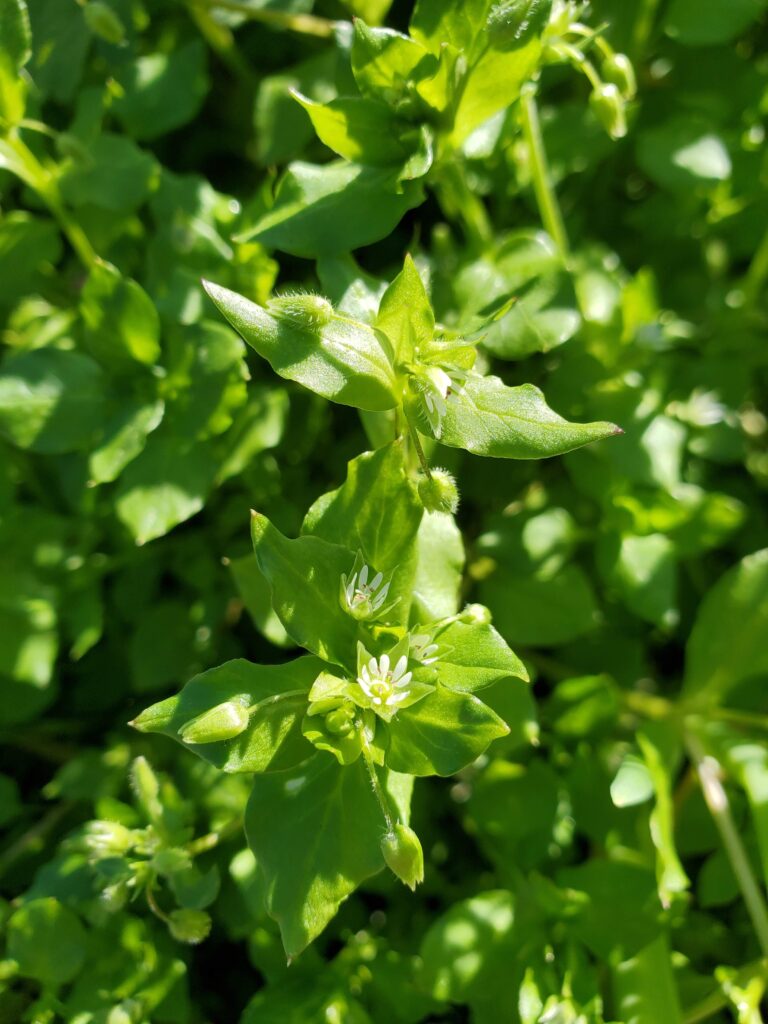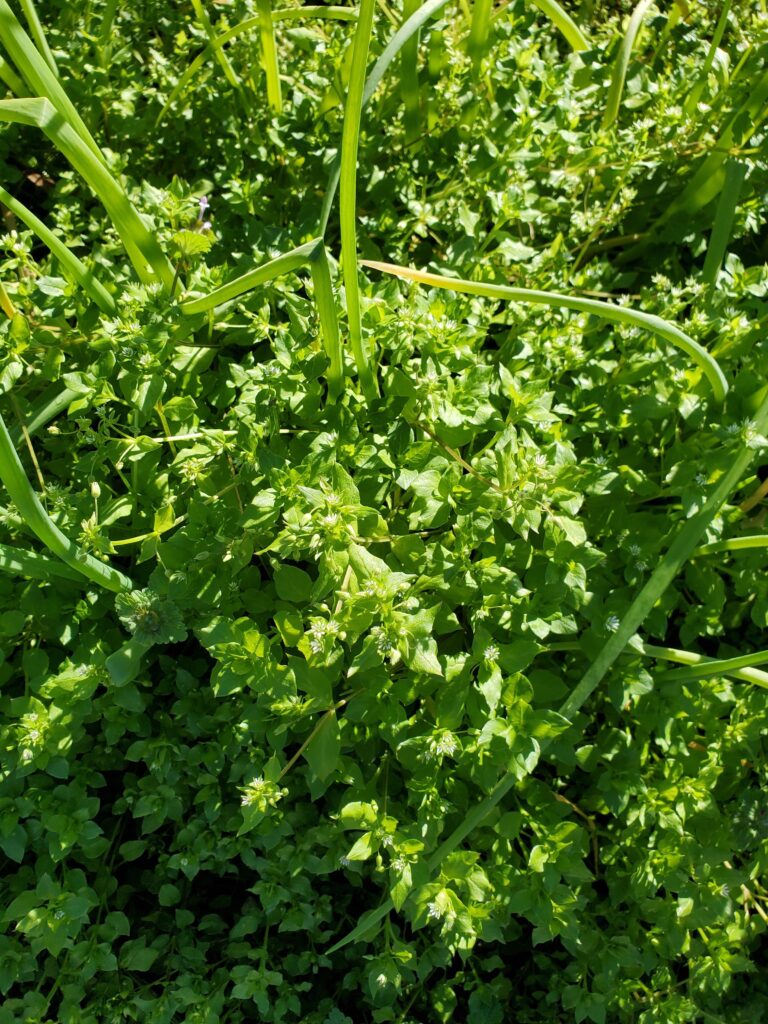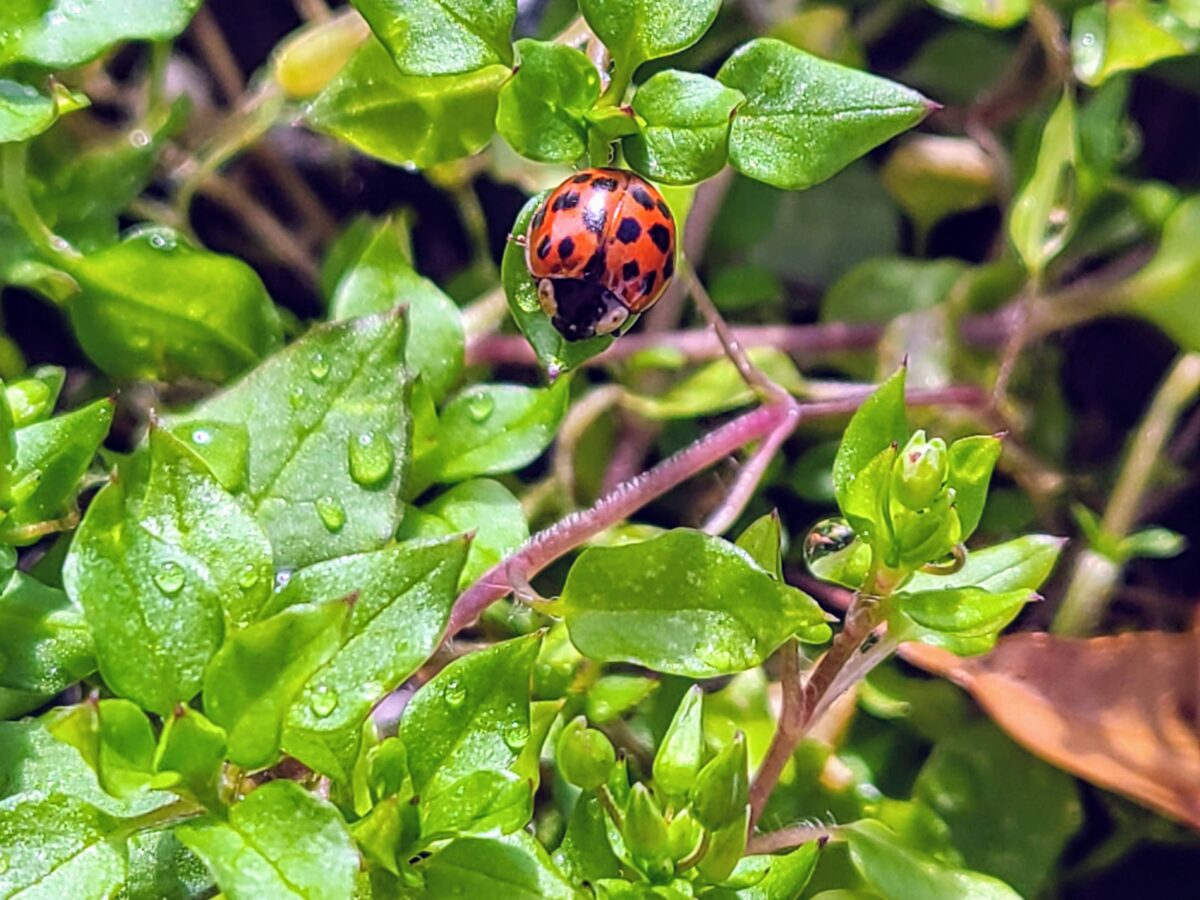Stellaria media
Other common names: chickenwort, craches, maruns, winterweed, Alsine media, capiqui, Fleur en Satin, Herbe de Langue, Morgeline, Mouron des Oiseaux, Star Chickweed, Starweed, Stellaire Intermédiaire, Stellaire Moyenne.
Spanish: Pamplina, hierba gallinera
Portuguese: Pamplina, yerba pitero
Japanese: 繁縷 (はこべら hakobera), 繁縷 (はこべら hakobera)
Hindi:Buch-bucha
Mandarin:繁缕The word Stellaria is derived from the word ‘stellar’ meaning ‘star’, which is a reference to chickweed’s beautiful star shaped flowers. Media is derived from Latin and means ’middle,’ ‘between’, ‘intermediate’, or ‘mid-sized.’
The roots of Stellaria dichotoma, a cousin, are used in Chinese Traditional Medicine and known as cha qi fan lu roots.
Identification


You can find wild chickweed in early spring and into later spring in the shadier spots of lawns and yards. The plant tends to look long and spindly in our North Florida region (8b). Leaves are typically bright green and have a classic leaf shape and sometimes more tear-drop shaped leaves. The leaves grow in pairs in an alternating direction. So if the pair above is growing left to right, the one below would grow top to bottom, or north to south.
The flowers (my favorite) are white with 5 petals. However, the deeply indented shape of the petals gives the appearance of the flower having 10 petals. See pictures.
Chickweed has a line of hairs down the stem that alternates sides at every leaf pair. This hair is also visible on unopened flower buds. This detail is important as it helps distinguish it from toxic lookalikes, Scarlet Pimpernel & Spurge.1 Another characteristic that sets chickweed apart from these lookalikes is that when torn it does not produce white, milky sap.
Growing/Foraging
While chickweed is not a native, it is not considered invasive and has been naturalized throughout most of North America. It is originally from Europe and the Indian subcontinent. It seeds very easily. If you wild forage, the seeds will drop naturally as the plant dries. Just make sure to beat the heat of Florida’s spring/summers. The plant prefers cool weather and doesn’t survive long in our state’s high heat.
Sustainability
Forage from where the plant is growing abundantly in February to mid April. If you live further north, you may be able to forage for it until the summer months. Ecologically, the larvae of the North American pale-banded dart (Agnorisma badinodis) moth, dusky cutworm (Agrotis venerabilis) moth, and the dainty sulphur (Nathalis iole) butterfly all feed on chickweed.
Medicinal and Food Properties
The leaves and flowers of this plant are edible and eaten both raw and cooked. Flowers and leaves are used like sprouts in sandwiches or tossed into salads, stir fries, stews, and/or pesto.2 It is also known as one of the ingredients of the symbolic dish consumed in the Japanese festival, the Festival of Seven Herbs or Nanakusa-no-sekku.3 It originated in China and was adapted in Japan during the Edo era (1603-1867). The practice is considered lucky, is celebrated on January 7, and heralds the spring.
Chickweed is best eaten fresh and does not keep well in the fridge. Plan to harvest this plant when you are ready to use it or to create a tincture from it. As its name suggests, it is also a favorite of birds and is often used to feed chickens. Chickweed contains vitamins A and C, carotene, magnesium, phosphorus, and is rich in calcium, potassium, iron, and silicon. 4 5
Chickweed is a cooling plant. Medicinally this plant is often used in topical preparations such as salves and creams for conditions such as diaper rash, psoriasis, itching, insect bites, and muscle and joint pain. It has also been used for more dire injuries such as a plaster for broken bones and swelling. A 2012 rat study showed potent peripherally and centrally mediated anti-inflammatory and analgesic properties.6
Chickweed is also an effective treatment for eye inflammation caused by environmental irritants or other conditions that cause eye inflammation such as glaucoma. A poultice applied to the eyes every evening is recommended for these conditions.
It is also used medicinally as a tonic, diuretic, demulcent, expectorant, and mild laxative 7. It is used in preparations for urinary tract infections and cystitis along with cleavers, cranberries, uva-ursi,and marsh mallow root.8 The same properties that make it an anti-inflammatory can aid in digestive inflammation and the prevention and treatment of ulcers (with milky green tops of oats, licorice root, and marsh mallow). The whole plant of Stellaria media has been tested for its antiobesity activity by using a progesterone-induced obesity model in female albino mice.9 Likewise, it has shown promise for diabetes via the moderation of blood sugar.10 11 Overall the plant is beneficial to the liver and the entire lymphatic system (circulation and immunity).12
Anecdotally and traditionally, many have found chickweed to be helpful in dissolving cysts, particularly ovarian cysts.13 It is also a beneficial supplement during menopause due to its high concentration of calcium.
Last, preliminary studies into the anti-hepatitis B virus (HBV) activity of S. media was evaluated in vitro using human HBV-transfected liver cells. Chickweed possesses potential anti-HBV activity.14
Safety
Like beans, chickweed contains saponins, which create a soap-like substance that helps our cells open up (makes them more permeable), and can be toxic when eaten in large quantities. As such, the raw plant is not recommended for pregnant or nursing mothers. Saponins are naturally broken down by the process of cooking.15 In larger mammals (humans included) harm is rare, but indigenous people used plants with saponins in rivers to disable fish for consumption. Saponin is the substance that causes foam when you make tea from chickweed. In limited amounts saponins are helpful to humans as they allow our bodies to absorb more nutrients and more easily get rid of waste and break down fat. In addition, it may produce skin allergy in some. It is recommended you do a skin test patch before more serious topical application.
Recipes
Chickweed Pesto 16
Ingredients
- ▢ 1/2 cup walnuts, cashews, or pine nuts
- ▢ 2-3 cloves garlic minced
- ▢ 3 cups chickweed loosely packed
- ▢ 1 Tbsp lemon juice
- ▢ 1/2 cup extra virgin olive oil
- ▢ 1/2 tsp salt
- ▢ 1/4 tsp freshly ground black pepper
- ▢ 1/4 cup freshly grated Parmesan cheese
Instructions
- Place all ingredients into a food processor and process until smooth. (A blender can be used instead, but the chickweed should be finely chopped first so it doesn’t wrap around the base of the blender).
- If it’s too thick, slowly drizzle in a bit more olive oil.
Notes
Keep refrigerated and eat or freeze within 3-4 days.
Nutrition
Serving: 2 Tbsp | Calories: 94kcal | Carbohydrates: 1.4g | Protein: 2.5g | Fat: 9.4g | Saturated Fat: 1.5g | Cholesterol: 3mg | Sodium: 108mg | Fiber: 0.7g
Chickweed Tincture: Ovarian Cyst Treatment
Instructions
- Wash and dry your chickweed and sterilize a mason jar.
- Fill a sterilized, dry mason jar ⅔ of the way with the fresh chickweed.
- Cover the chickweed completely in high content alcohol (like 100 proof vodka), diluted vegetable glycerin*, or apple cider vinegar. The liquid should be 2 to 3 inches above the plant material and about an inch from the top of the jar.
Note: *If you are using glycerin, you will need to dilute it with equal part distilled water before pouring over the herbs. If using vinegar, it is recommended it is warmed first.17 - Cover with a tight-fitting lid and store away from sunlight for about 4 weeks. Shake the jar once a day.
- Strain the chickweed out using a cheesecloth or similar.
- Store in amber jars, keep in a cool place, and use as needed.
Take a full dropper of chickweed tincture made from the fresh herb 2-3 times daily. This may take up to 4 months of consistent use.
Susun Weed also tells of a woman who combined chickweed, motherwort (Leonurus cardiaca), and cronewort (Artemisia vulgaris) tinctures in equal parts to get rid of a dermoid cyst. Dermoid cysts can typically be more problematic on account of being made up of totipotential germ cells, stem cells, the type of cells present at birth that can transform into any type of specialized cell. As such, dermoid cells can typically create hair, teeth, and etc.
Chickweed Poultice: Eye or Skin Inflammation Treatment
Instructions
- Wash, dry, and finely chop chickweed and place in a bowl.
- Slowly add warm water, bit by bit, and gently stir the herb until you have formed a pulp mash.
- Place inside a soft cotton cloth.
- Place over the affected area for about 20 minutes.
Note: You can alternatively place directly on wounds on the skin and even mix it with aloe instead of water.
Sources

